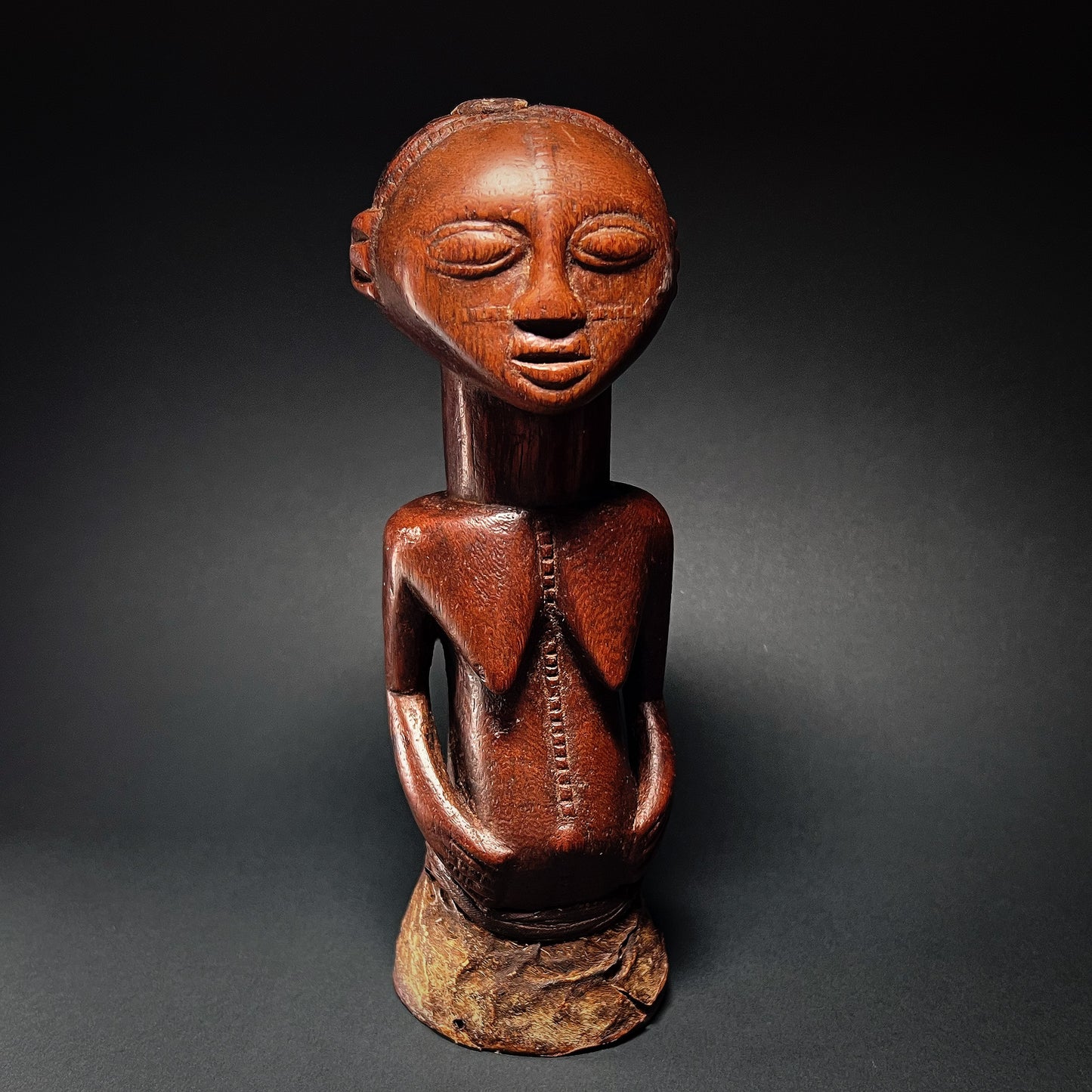Luba Female Power Half Figure (Kakudji)
Luba Female Power Half Figure (Kakudji)
Couldn't load pickup availability
Luba people, early to mid-20th century, possibly Lukuga River Region, Democratic Republic of the Congo
Magnificent and rare kakudji female power half-figure, superbly carved from a single piece of dense hardwood. The figure stands upright in a posture of composed spiritual authority, her sensitively rendered features including a short, close-cropped coiffure above large almond-shaped eyes, a short flattened nose, and an oval raised mouth with full lips over a pointed chin. A strong neck supports squared shoulders and pointed breasts, while long tubular arms extend downward, the hands placed firmly upon the prominently modeled abdomen with its accentuated navel. The sculptor has achieved fluid, harmonious lines and beautifully rounded surfaces, creating a sense of inner poise and embodied power.
Her entire torso is adorned with refined raised scarification (ntaho), composed of complex vertical and horizontal bar patterns that reference both beauty and elevated status. The figure terminates in a round plinth, carved from the same piece of wood and partially covered with animal skin. A cavity in the top of the head—filled with sacred substances—indicates her role as a vessel for potent spiritual force.
The figure’s gesture, with hands calmly resting upon the rounded belly, conveys both grounded presence and meditative connection to the unseen world. Her forward-gazing eyes reinforce the duality of being anchored in the physical realm while serving as an intermediary to ancestral spirits.
The Luba comprise a wide cluster of peoples inhabiting south-central Democratic Republic of the Congo. Their kingdoms flourished between the 17th and 19th centuries, and their artists—especially those of the Luba Shankandi and Hemba communities—are renowned for masterful anthropomorphic sculpture, caryatid stools, ceremonial axes, and headrests. Luba blacksmiths, revered as holders of esoteric knowledge, maintained prestige for their mythically inherited skills.
Female imagery dominates Luba art because women hold exceptional social and spiritual status as life-bearers, priestesses, and high-ranking officiants. More importantly, only the body of a woman was believed capable of containing the powerful spirit of a deceased king. As Mary Nooter Roberts and Allen F. Roberts famously wrote:
“Luba people say that only a woman’s body is strong enough to contain a powerful spirit like a king’s, so sculpture dedicated to kingship is almost always female in gender.”
(Memory: Luba Art and the Making of History, 1996, p. 42)
A superb, spiritually resonant example of Luba sculptural tradition—elegant, authoritative, and richly imbued with the visual language of female power and ancestral presence.
Excellent condition. Wear consistent with age and use. Minor abrasion. Smooth polished surface patina. Beautiful reddish brown color. Size approx. 21,5cm x 7,0cm x 6,0cm.
Provenance: Swedish private collection.
For a similar examples see:
Truncated Female Figure (Kakudji), The Yale University Art Gallery, Accession Number: 2014.121.7 (https://artgallery.yale.edu/collections/objects/112382)
Female Luba Figure, High Museum of Art, Accession Number: 2009.155 (https://high.org/collection/female-luba-figure/)
References and further reading:
Luba: Visions of Africa, Mary Roberts & Allen F. Roberts, Publisher: 5 Continents Editions Srl, 2007.
Memory: Luba Art and the Making of History, Mary Nooter Roberts & Allen F. Roberts, Publisher: Center for African Art, 1996.
Luba, Mutombo Nkulu-N'Sengha, Encyclopedia Britannica, 2 Dec. 2018. (https://www.britannica.com/topic/Luba-people)
History of Art in Africa: Second Edition, Monica Blackmun Visona, Robin Poynor and Herbert M. Cole, Publisher: Prentice Hall, 2007.






-
Shipping
The shipment will be prepared in the course of 3-5 days and dispatched via Posti Group Oyj or purchased item(s) can be picked up from our shop during the store's opening hours (Tarkk’ampujankatu 4, 00140, Helsinki, Finland). Within the Finland, all items are shipped via Posti Group Oyj unless otherwise requested. We pack the items carefully and mainly in recycled materials because we want to save nature. You will receive the tracking number for your items by e-mail.
-
Returns
Returns and exchange will be accepted within fourteen days (14) of receipt at the purchaser’s cost to include freight and packaging. Items must be returned in the same condition as when they were shipped, and will not be accepted if damaged or altered in any way. Please inform us via email (info@gotanmaailma.fi) or by calling +358408408352 before sending. We do not accept returns more than 14 days after delivery.






